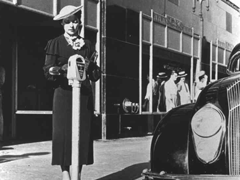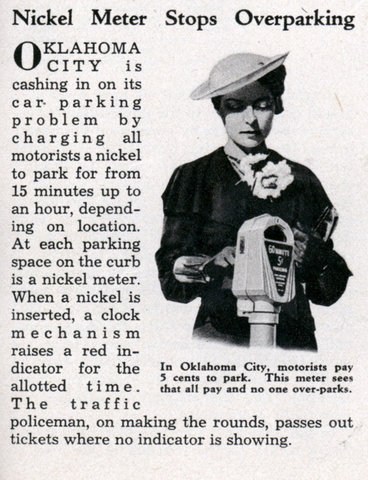Parking Meter History
 The first working fully coin operated operational parking meter was designed in 1935 by an engineering professor at Oklahoma Agricultural and Mechanical College (now Oklahoma State University), Holger George Thuesen, and former engineering student and 1927 OSU graduate, Gerald A. Hale. The parking meter was dubbed the “Black Maria.”
The first working fully coin operated operational parking meter was designed in 1935 by an engineering professor at Oklahoma Agricultural and Mechanical College (now Oklahoma State University), Holger George Thuesen, and former engineering student and 1927 OSU graduate, Gerald A. Hale. The parking meter was dubbed the “Black Maria.”
Work began on the parking meter in 1933 at the request of Oklahoma City lawyer and newspaper editor Carlton C. Magee (January 1872 – February 1946).
Why would anyone, anywhere, place the scourge of parking meters upon the globe, you ask? Who was Carlton C. Magee? We, too, asked the same questions.
As history goes, in the pre-1930s, there was free, unregulated reign on downtown parking in Anywhere, USA. There wasn’t any regulated parking in Oklahoma City either, as it turns out. Since retail employees occupied most of the available parking spaces, there was no room for customers to park. Traffic back-ups were a persistent problem, clogged streets added to the congestion, and shoppers/motorists impatiently honked their horns for mercy and a place to park. But most of all, businesses were losing revenue as shoppers went elsewhere. It was high time that someone launched a way to regulate parking.
Enter Carlton C. Magee, who recently moved from New Mexico to Oklahoma City, Oklahoma, in 1927. That’s just before the opening of the Oklahoma City Oil Field in 1928. The enormous oilfield added security to the state’s economy during the Great Depression and produced some 7.3 million oil barrels over the next 40 years.
With big business comes people, and with people comes cars. (Statistics reveal that between 1913 and 1930, the number of vehicles registered in Oklahoma shot up from 3,000 to an astronomical 500,000. Great balls of fire, that’s a lot of cars.)
Anyways, Carlton had previously worked as a reporter for an Albuquerque newspaper and exposed the Teapot Dome scandal and testified against Secretary of the Interior Albert B. Fall. Keeping all this in mind, it’s safe to say Carlton must’ve been a bulldog for solving pressing issues.
As January 1933 approached, the parking problem was well out of hand and then some. Downtown Oklahoma City retailers, local government, and Chamber of Commerce, all feeling the pinch of revenue losses and searching for a resolution, launched a traffic committee with Magee as its chairman. As it turns out, Carlton was in the right place at the right time–he was the perfect individual to chair the parking committee.
 Magee felt the best resolution to the parking dilemma was to assess a charge for parking. But how? Magee explained that employing a mechanical timer in each space would solve the City’s headaches. To further demonstrate his idea, Magee developed a rudimentary prototype. He also applied for its’ patent on December 21, 1932, and established the Magee-Hale Park-O-Meter Company.
Magee felt the best resolution to the parking dilemma was to assess a charge for parking. But how? Magee explained that employing a mechanical timer in each space would solve the City’s headaches. To further demonstrate his idea, Magee developed a rudimentary prototype. He also applied for its’ patent on December 21, 1932, and established the Magee-Hale Park-O-Meter Company.
Aware that his prototype wasn’t hitting on all cylinders, Magee launched a design competition with prize money of $160 for the winning design and $240 for the submission of a working model. The contest ran from February 17 through May 6, 1933. open to the Oklahoma Agricultural and Mechanical College students to design a working prototype. Though a variety of designs were presented, students weren’t able to assemble a working model.
Thuesen and Hale stepped up to the plate (parking meter) when all hope seemed lost and created Magee’s prototype. The prototype withstood the test of durability and time–cost-efficient, weather-resistant, and security proof. They hit paydirt.
Anxious to test the meter’s effectiveness, they were installed on one side of the street in Oklahoma City for a test run. The initial cost for the meters was 5 cents an hour. The meters seemed to be the answer the city retailers, local government, and the Chamber of Commerce was seeking. Three days after their installation, retailers across the street appealed to the local government to install meters on their side of the street. Oklahoma City’s traffic movement improved, and the traffic jams were resolved.
Industrial production started on the parking meter in 1936. Magee received a patent for the improved parking meter apparatus on May 24, 1938. (In the fairness of history, it’s important to note that the first patent for a parking meter was filed by Roger W. Babson ten years earlier, on August 30, 1928. The parking meter’s power was derived from a parked vehicle’s battery-thus necessitating a unique connection from the vehicle to the meter.)
The parking meter models were based on a coin acceptor, a dial to employ the device, and an obvious indicator to register the paid session’s termination. The metered model endured for more than 40 years, with a few minor changes to its exterior design–the double-headed design for incorporating two adjoining parking spaces alongside the inclusion of new materials and production procedures.
Interesting facts:
The world’s first installed parking meter was installed at the corner of First Street and Robinson Avenue in downtown Oklahoma City on July 16, 1935.
Reverend CH North of Oklahoma City was given the first ticket ever issued for a parking meter violation in 1935. North took the parking meter company to court. He lost his case.
In 1936, M.H. Rhodes Inc. of Hartford, Connecticut, started making meters for the Mark-Time Parking Meter Company of Miami. Rhodes meters were distinctly different from Magee’s design because only the driver’s action of turning a handle was needed to keep the spring-wound. In contrast, Magee’s meters required a specialist to wind the spring occasionally.
The Magee-Hale Park-O-Meter Company later changed its name to POM (the initials of Park-O-Meter) and is still active in producing parking meters today.
In 1960, New York City retained its first crew of “meter maids”; all were women. In 1967 the first man was hired as a ‘meter maid.”
In the mid-1980s, a digital version parking meter was introduced, transitioning the mechanical components with electronic components: boards, keyboards, and displays.
By the beginning of the 1990s, millions of parking meter units were marketed around the world. Today, new solutions, including collective pay and display machines and new payment forms, are developed along with electronic money and communication technologies.
References:
History Lesson: https://www.parking-net.com/parking-industry-blog/history-lesson-the-first-parking-meter
Oklahoma Historical Society
Parking meter – Wikipedia. https://en.wikipedia.org/wiki/Parking_meter

POLICE INFORMATION
If you have copies of: your Baltimore Police Department Class Photo, Pictures of our Officers, Vehicles, Equipment, Newspaper Articles relating to our department and or officers, Old Departmental Newsletters, Lookouts, Wanted Posters, and or Brochures. Information on Deceased Officers and anything that may help Preserve the History and Proud Traditions of this agency. Please contact Retired Detective Kenny Driscoll.
This email address is being protected from spambots. You need JavaScript enabled to view it.

NOTICE
How to Dispose of Old Police Items
Please contact Det. Ret. Kenny Driscoll if you have any pictures of you or your family members and wish them remembered here on this tribute site to Honor the fine men and women who have served with Honor and Distinction at the Baltimore Police Department. Anyone with information, photographs, memorabilia, or other "Baltimore City Police" items can contact Ret. Det. Kenny Driscoll at This email address is being protected from spambots. You need JavaScript enabled to view it. follow us on Twitter @BaltoPoliceHist or like us on Facebook or mail pics to 8138 Dundalk Ave. Baltimore Md. 21222
Copyright © 2002 Baltimore City Police History - Ret Det Kenny Driscoll


 The first working fully coin operated operational parking meter was designed in 1935 by an engineering professor at Oklahoma Agricultural and Mechanical College (now Oklahoma State University), Holger George Thuesen, and former engineering student and 1927 OSU graduate, Gerald A. Hale. The parking meter was dubbed the “Black Maria.”
The first working fully coin operated operational parking meter was designed in 1935 by an engineering professor at Oklahoma Agricultural and Mechanical College (now Oklahoma State University), Holger George Thuesen, and former engineering student and 1927 OSU graduate, Gerald A. Hale. The parking meter was dubbed the “Black Maria.” Magee felt the best resolution to the parking dilemma was to assess a charge for parking. But how? Magee explained that employing a mechanical timer in each space would solve the City’s headaches. To further demonstrate his idea, Magee developed a rudimentary prototype. He also applied for its’ patent on December 21, 1932, and established the Magee-Hale Park-O-Meter Company.
Magee felt the best resolution to the parking dilemma was to assess a charge for parking. But how? Magee explained that employing a mechanical timer in each space would solve the City’s headaches. To further demonstrate his idea, Magee developed a rudimentary prototype. He also applied for its’ patent on December 21, 1932, and established the Magee-Hale Park-O-Meter Company.















